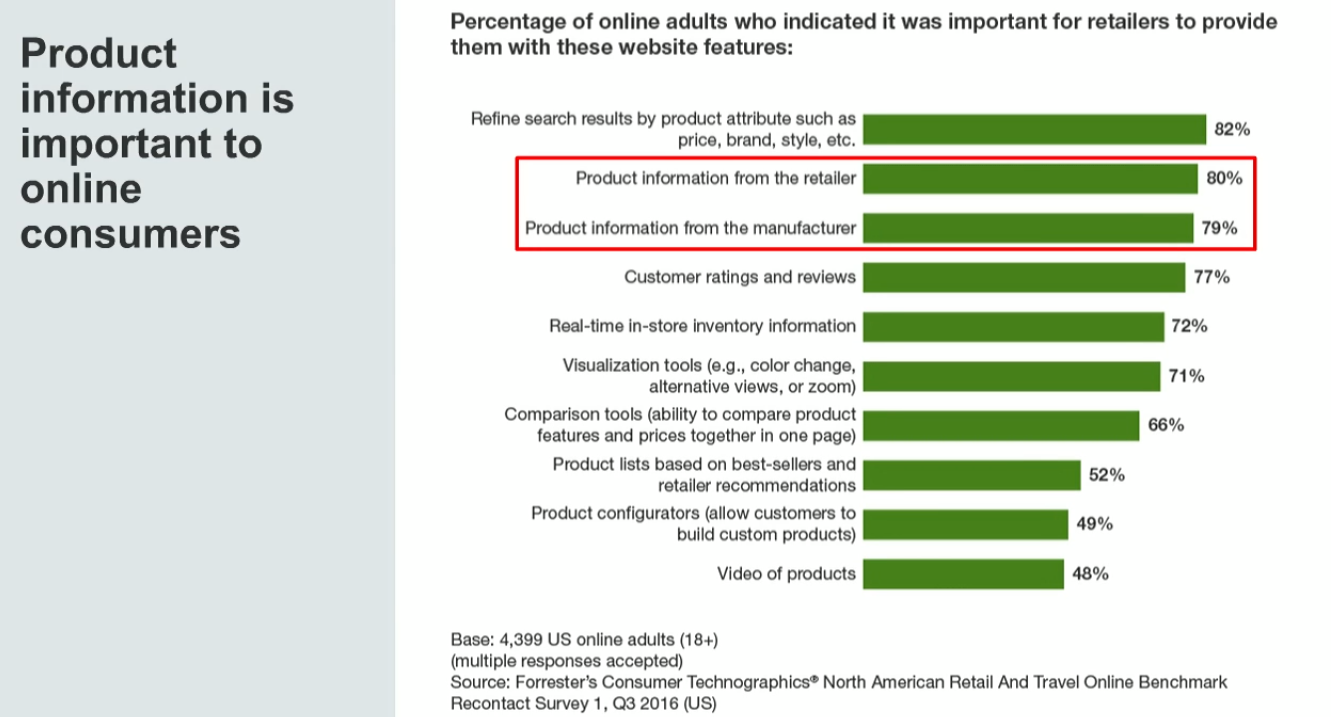The face of digital retail looks promising as many e-commerce giants are challenging the status-quo of traditional retail. Technology leaders are obsessed with developing tools and software aimed at driving sales.
According to a webinar by Forrester Research, digital influences ½ of the retail market, especially in the United States. This does not imply that 50% of the population is making online purchases, but this number is symbolic of how digital influences the retail scenario which manifests in the form of product information.
Customers are investing more time in acquiring information and researching products prior to making a decision. As a result, organizations need to be obsessed with supplying that demand by providing accurate, complete and correct product information.

Product Information is important to online customers (Source: Forrester Research Webinar featuring Riversand)
It takes a product content obsessive organization to nail digital retail.
And here are the key areas organizations need to be obsessive about:
1. The Process of Acquiring and Collecting Data
Organizations depend upon various entities such as retailers, suppliers, and manufacturers to directly supply the product information. This requires third parties to add product information through tools and systems on the organization’s online store or website. Since product content comes from multiple sources or entities, organizations need to collaborate with other stakeholders in generating and compiling data. While one organization or team can be responsible for aggregation of product content, collaboration with others is the most effective way of rapidly building and maintaining high-quality product content.
2. Data Quality
Data Quality is another area successful organizations in digital retail are obsessed about. Data Quality is important as end users need trusted data in order to make a purchase. Organizations need to constantly validate, approve and audit data in order to keep data quality levels up.
Product data-obsessed organizations invest in refining validation rules, quality check workflows and also develop auditing processes to ensure it’s not a one-time activity.
Amazon even has “Submit Content Corrections” section where customers can report incorrect product information. Hence, all stakeholders become a part of the data quality process which is rudiment for generating sales.
3. Number of Attributes
When it comes to product attributes, 10 is better than 5 and 100 is better than 10. End users make purchasing decisions based on these attributes and the more detail they have about a product, the better equipped they are to make that decision and the higher the conversion rates.
Attribute frequency may vary for various categories. For example, attributes for apparel products will differ from electronics. However, supplying additional information and data enrichment is instrumental in generating business.
Also, marketplace suppliers need to support this data with High-Quality Images and Videos, which eventually help the customer in making a decision. Organizations that are successful in digital retail are obsessed about the detail level they can offer for each product.
4. Making Product Content Available on Demand
Distribution technology such as Qliktag’s product data hub lies at the core of digital retailing by playing a critical role in ensuring availability of product content in the correct format instantly when needed. Organizations with digital goals aggressively invest in technology systems to get their data to where it’s needed quickly and securely.
Robust technology systems are essential in enhancing the shopping experience for customers and refining the internal processes for organizations.
“In retail, customers demand experiences, not just information.” – Nasry Angel, Forrester Research
Product content obsessive organizations are nailing digital retail by focussing on the things needed to supply great product content where the purchases are happening. By putting the focus on data, they’re able to provide the foundation for fuel the digital retail industry is run on.



